
|
Dec 16, 2008
Defying Predictions, Sea Level Rise Begins to Slow
By Michael Asher, Daily Tech
World’s oceans rise slower since 2005, fail to display predicted accelerating trend. Satellite altimetry data indicates that the rate at which the world’s oceans are rising has slowed significantly since 2005. Before the decrease, sea level had been rising by more than 3mm/year, which corresponds to an increase of about one foot per century. Since 2005, however, the rate has been closer to 2mm/year.
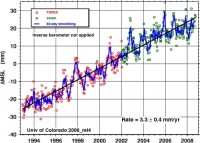
Source: University of Colorado, Boulder
The decrease is significant as global climate models predict sea level rise to accelerate as atmospheric CO2 continues to increase. In the 1990s, when such acceleration appeared to be occurring, some scientists pointed to it as confirmation the models were operating correctly. Sea level rise was calculated from altimetry data from the TOPEX/Poseidon and Jason-1 satellite missions, published by the University of Colorado, Boulder.
Dr. James Choe, a research associate with the University of Colorado, says the decrease is temporary. “Interannual variations often cause the rate to rise or fall”, he says. Choe believes an accelerating trend will reappear within the next few years. Oceanographer Gary Mitchum of the University of South Florida, says making any judgement from the limited data available is “statistically so uncertain as to be meaningless”.
Others disagree. Dr. Vincent Gray, a New Zealand based climatologist and expert reviewer for the IPCC, believes that the accelerated trends seen earlier were simply an artifact of poor measurements. “The satellite system has undoubtedly shown a rise since 1992, but it has leveled off”, he tells DailyTech. “They had some bad calibration errors at the beginning.” Gray points to a study done by Flanders University using tide gauges which, he says, measured no perceptible increase in sea level over its entire 15 year period.
Sea level has been rising since the end of the last ice age, some 20,000 years ago. During an episode known as “Meltwater Pulse 1A”, the world’s oceans rose by more than 5 meters per century, a rate about 20 times faster than the current increase. TOPEX/Poseidon was launched by NASA in 1992, and collected data until 2005. In 2001, NASA and France’s Centre National d’…tudes Spatiales (CNES) launched its follow-up mission, Jason-1. Jason-2 was launched in June of this year. Read more here.
Dec 14, 2008
Global Warming is Caused by Computers
Climate Skeptic
In particular, a few computers at NASA’s Goddard Institute seem to be having a disproportionate effect on global warming. Anthony Watts takes a cut at an analysis I have tried myself several times, comparing raw USHCN temperature data to the final adjusted values delivered from that data by the NASA computers. My attempt at this compared the USHCN adjusted to raw for the entire US:
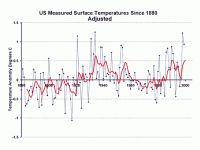
See animation before and after adjustment here.
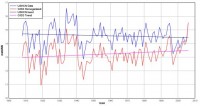
See larger image here.
Anthony Watts does this analysis from USHCN raw all the way through to the GISS adjusted number (the USHCN adjusts the number, and then the GISS adds their own adjustments on top of these adjustments). The result: 100%+ of the 20th century global warming signal comes from the adjustments. There is actually a cooling signal in the raw data:
Now, I really, really don’t want to be misinterpreted on this, so a few notes are necessary:
Many of the adjustments are quite necessary, such as time of observation adjustments, adjustments for changing equipment, and adjustments for changing site locations and/or urbanization. However, all of these adjustments are educated guesses. Some, like the time of observation adjustment, probably are decent guesses. Some, like site location adjustments, are terrible (as demonstrated at surfacestations.org).
The point is that finding a temperature change signal over time with current technologies is a measurement subject to a lot of noise. We are looking for a signal on the order of magnitude of 0.5C where adjustments to individual raw instrument values might be 2-3C. It is a very low signal-noise environment, and one that is inherently subject to biases (researches who expect to find a lot of warming will, not surprisingly, adjust a lot of measurements higher).
Warming has occurred in the 20th century. The exact number is unclear, but we have much better data via satellites now that have shown a warming trend since 1979, though that trend is lower than the one that results from surface temperature measurements with all these discretionary adjustments. See full post here.
Dec 12, 2008
Record Early Snow in New Orleans and Houston
By The Times-Picayune
New Orleans Metro area residents woke up to falling snow on Thursday, December 11, 2008. Snow in New Orleans is a rarity. The last time it snowed was Christmas 2004; before that, the last snow recorded was in 1989, according to Jim Vasilj, a forecaster with the National Weather Service. Since 1850, snow had fallen in “measurable amounts” rather than traces in the city just 17 times, Vasilj said. Of the 17, today’s snowfall was the earliest in the season recorded. As much as 6 inches had piled up in Livingston Parish as of 10 a.m., Vasilj said. Similar amounts were reported in Bogalusa and St. Helena Parish, while in Mandeville, between 2 and 3 inches had accumulated, according to Vasilj.
For the first time in nearly four years, snow fell across the New Orleans region this morning, with flurries reported on the north shore and in the city, Metairie, Kenner, LaPlace and other parts of the south shore. By around 10 a.m., the snow had mostly stopped, replaced by freezing rain in many places, making driving treacherous. By noon, the precipitation had mostly ceased altogether.

By mid-morning, enough snow had accumulated on the ground in some areas to lure children and adults onto their front lawns to build snowmen or have snowball fights. In the city, neutral grounds remained blanketed in white, though the streets generally remained clear as the wet stuff melted upon hitting the pavement. In Mandeville, where the snow was heavier, lawns were covered with thicker blankets of white fluff as school buses filled with squealing students made the rounds. Children, most seeing snow for the first time Christmas Day 2004, tried to catch flakes in their hands as the buses rumbled along.
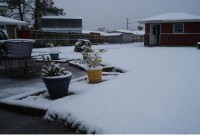
While snow in the Deep South is a pleasant novelty, the weather did cause trouble for some. A handful of schools and universities shut down for the day, bus service was disrupted, and flights at Armstrong International were cancelled or delayed. Outages were also reported in St. Tammany and Washington parishes, with the majority in the Franklinton area, according to Cleco spokeswoman Robbyn Cooper. Cleo has a total of nearly 7,000 power outages statewide, most of them in Allen, Evangeline, Acadia and St. Landry parishes. Read more here. Last night Houston too had the earliest snow on record. See also this official NWS summary of the snowfall in the New Orleans area last week. And courtesy of our friends at the METSUL who found this New Orleans Gore Snowman.
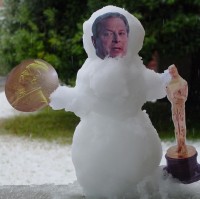
Dec 11, 2008
Solar Link to 50% of Warming During the Past 100 Years
By Paul Biggs, Climate Research News
There is a new paper ‘in press’ in Geophysical Research Letters by Eichler et al entitled, ‘Temperature response in the Altai region lags solar forcing’.The Abstract states:
The role of the sun on Earth’s climate variability is still much debated. Here we present an ice core oxygen isotope record from the continental Siberian Altai, serving as a high-resolution temperature proxy for the last 750 years. The strong correlation between reconstructed temperature and solar activity suggests solar forcing as a main driver for temperature variations during the period 1250-1850 in this region. The precisely dated record allowed for the identification of a 10-30 year lag between solar forcing and temperature response, underlining the importance of indirect sun-climate mechanisms involving ocean induced changes in atmospheric circulation. Solar contribution to temperature change became less important during industrial period 1850-2000 in the Altai region.
In the Results and Discussion the authors write: “Our reconstructed temperatures are significantly correlated with the 10Be and 14C based solar activity reconstructions in the period 1250-1850, but not with the greenhouse gas CO2. This indicates that solar activity changes are a main driver for the temperature variation in the Altai region during the pre industrial time. However, during the industrial period (1850-2000) solar forcing became less important and only the CO2 concentrations show a significant correlation with the temperature record. Our results are in agreement with studies based on NH temperature reconstructions [Scafetta et al., 2007] revealing that only up to approximately 50% of the observed global warming in the last 100 years can be explained by the Sun.”

Whilst this paper supports studies by Scafetta et al, it is clear that solar factors are still poorly understood, and there are many factors other than CO2 or Solar involved in climate change. A correlation with post industrial CO2 does not necessarily imply causation. For example, Tsonis et al, 2007 investigated the collective behavior of known climate cycles such as the Pacific Decadal Oscillation, the North Atlantic Oscillation, the El Nino/Southern Oscillation, and the North Pacific Oscillation. By studying the last 100 years of these cycles’ patterns, they found that the systems synchronized several times. In cases where the synchronous state was followed by an increase in the coupling strength among the cycles, the synchronous state was destroyed. Then, a new climate state emerged, associated with global temperature changes and El Nino/Southern Oscillation variability. The suggestion is that this mechanism explains all global temperature tendency changes and El Nino variability in the 20th century. See post here.
Dec 08, 2008
Rethinking Global Warming
World Climate Report
The United Nations Climate Change Conference is underway this week in Poznan, Poland, and literally thousands of folks have convened and reinforced the notion that the buildup of greenhouse gases has caused substantial warming in recent decades and that left unchecked, the continued buildup will undoubtedly cause significant warming in the decades to come. Believe it or not, it is possible that aspects of the traditional greenhouse gas explanation could be largely wrong, and if you think we are crazy, let’s visit an article just published in the prestigious journal Climate Dynamics. (Compo, G.P. and P.D. Sardeshmukh. 2008. Oceanic influences on recent continental warming. Climate Dynamics, DOI 10.1007/s00382-008-0448-9).
The interesting (to say the least) work was conducted by Gilbert Compo and Prashant Sardeshmukh of the Climate Diagnostics Center, Cooperative Institute for Research in Environmental Sciences and Physical Sciences Division, Earth System Research Laboratory, National Oceanic and Atmospheric Administration (these guys must have oversized business cards) and the work was supported financially by the NOAA Climate Program Office. The first sentence of the abstract reads “Evidence is presented that the recent worldwide land warming has occurred largely in response to a worldwide warming of the oceans rather than as a direct response to increasing greenhouse gases (GHGs) over land.” This sentence certainly captured our interest at World Climate Report - anyone suggesting that some warming may have been caused by something other than the buildup of greenhouse gases will always get a second look.
The approach used by Compo and Sardeshmukh is actually quite simple and clever. The pair collected sea surface temperature data from 1961 to 2006 and they determined the difference between the 1991-2006 and 1961-1990 sub-periods. As seen in the Figure 1 below, the oceans of the world generally warmed between the two sub-periods. Next, they took only the change in SSTs to force global climate responses in a suite of climate models. Basically, instead of increasing greenhouse gas (GHG) concentration to examine the global climate response, they wondered how the climate would be impacted by the spatial pattern of sea surface temperature changes over the global oceans. In addition, they conducted a set of numerical modeling experiments that did include the set of known forcings “included time-varying solar irradiance and volcanic aerosols, anthropogenic sulfate aerosols, tropospheric and stratospheric ozone, well-mixed GHGs (CO2, CH4, N2O), halocarbons, and black carbon aerosols.”
In the second sentence of their abstract, Compo and Sardeshmukh tell us “Atmospheric model simulations of the last half-century with prescribed observed ocean temperature changes, but without prescribed GHG changes, account for most of the land warming.” Are they kidding? Are they really suggesting that the warming of the land areas of the Earth may not have been caused directly by the increased concentration of greenhouse gases? The answer is ... yes!
Their figure shows the results and to the amazement of the greenhouse advocates, the model runs forced by SSTs only did as good a job replicating the observed temperature rise as the model runs with elevated greenhouse gases or the many other forcings explored in their research. In explaining their results, the scientists write “In summary, our results emphasize the significant role of remote oceanic influences, rather than the direct local effect of anthropogenic radiative forcings, in the recent continental warming. They suggest that the recent oceanic warming has caused the continents to warm through a different set of mechanisms than usually identified with the global impacts of SST changes. It has increased the humidity of the atmosphere, altered the atmospheric vertical motion and associated cloud fields, and perturbed the longwave and shortwave radiative fluxes at the continental surface.”

See larger image here
Time will tell, but don’t look for a lot of press coverage coming from the Poland meeting of this interesting research challenging the gospel of global warming. Read much more here. This fits what we have been saying for years and most recently here and here.
|
|
|
|










